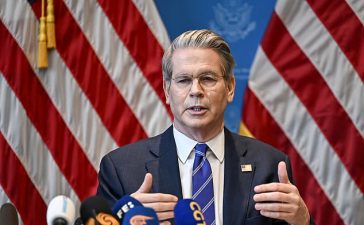
Two women paddle in 2005 on Little Tupper Lake, which the state of New York bought from the Whitney family in 1997 as part of a 15,000-acre purchase. One of the Whitneys’ former houses is seen on the far shore.
(Enterprise file photo)
LONG LAKE — John Hendrickson, a philanthropist and significant landowner in the Adirondacks, died on Aug. 19 at Saratoga Hospital in Saratoga Springs. With his death, the fate of a large swath of land he owns in the Adirondacks is now unclear.
Hendrickson was the owner of a 36,202-acre tract of land in Long Lake known as Whitney Park. He had been trying to sell the land in its entirety since 2020. He originally sought to sell the property in one chunk for $180 million. Hendrickson said at the time that he did not want to sell the land to the state for it to conserve, nor did he want to sell it to private buyers who wanted to develop the land, according to an Aug. 2020 interview with the Adirondack Explorer. Hendrickson appraised and listed the property through his company, Whitney Industries, LLC, rather than a separate real estate brokerage firm. No sale agreement was reached before Hendrickson’s death.
Hendrickson was the husband of the late Marylou Whitney, a prominent socialite and philanthropist. Before her marriage to Hendrickson, she was married to Cornelius Vanderbilt “Sonny” Whitney. Sonny Whitney inherited massive tracts of land between Long Lake and Tupper Lake from his grandfather, William C. Whitney, who consolidated and purchased 80,000 acres of land in that area in 1897. He paid $1.50 per acre at the time.
Portions of the original holdings were sold to the International Paper Company over time, leaving about 48,000 acres at the time of Sonny Whitney’s death in 1992. This was passed on in its entirety to Marylou Whitney.
In 1997, just after marrying Hendrickson, the couple sold approximately 15,000 acres of the tract to New York for $17.1 million. The state classified the area as a wilderness zone, its most stringent level of conservation protection for land, and named it in honor of William C. Whitney.
While Hendrickson’s most notable philanthropy was centered around thoroughbred horse racing in the Saratoga Springs area, locally he was seen as a generous supporter of the Long Lake community and a good steward of Whitney Park. The couple gifted $250,000 to the Long Lake Library in 2007. The donation was the largest in its history and the library’s board voted to rename it the Cornelius Vanderbilt Whitney Library in the family’s honor, according to Long Lake Historian Hallie Bond. The Whitney family also donated to the town’s medical center and provided a World War I memorial statue for Long Lake, Bond said.
While Bond said that family members began visiting Whitney Park and Long Lake less after Sonny and Marylou Whitney’s deaths, Whitney Industries continues to employ some Long Lake residents between land management and maintaining the historic buildings throughout the property, she said.
After Marylou’s death, Hendrickson told the Adirondack Explorer that it had become increasingly lonely for him without her, and no longer wished to own much of the land in the Adirondacks that they once shared. Hendrickson put Whitney Park’s entire 36,000-acre property on the market for $180 million in 2020. He was adamant about not wanting to sell to the state, given his reservations about their conservation practices and a desire to not see the historic buildings on the property removed as an aspect of it being classified as a forest preserve. Camp Deerlands, perched on the eastern shore of Little Forked Lake, is widely considered the most significant structure in Whitney Park. It boasts 17 bedrooms and 11 bathrooms between the main camp and adjoining guest and staff quarters.
Hendrickson, however, was equally clear that he would not sell the land to be developed. He claimed to have turned down six offers, including one at the full $180 million listing price, because the prospective buyers wanted to develop the land, in an interview with the Adirondack Explorer.
Hendrickson told the Albany Times Union in 2021 that he was considering subdividing Whitney Park into 11 lots to make it easier to find appropriate buyers, given his trouble finding a buyer for the property in its entirety. Subdivision permits would have needed to be reviewed and approved by the Adirondack Park Agency. Benjamin Brosseau, a public information officer with the APA, confirmed on Monday that no subdivision permit applications for Whitney Park have been filed to date.
Conservationists have long pushed for Whitney Park to become a forest preserve. They cite its vast wetlands, including over 100 miles of shoreline spread across 22 lakes.
“It’s a critical piece of the landscape in the Adirondacks. Its wetlands serve so many ecological roles. It was recognized early on as being a very important zone for resource management,” said David Gibson, managing partner of Adirondack Wild, an advocacy group that supports wilderness preservation throughout New York.
Gibson believes that Whitney and Hendrickson were good stewards of the land while they owned it, but pushed back on the claim that New York state lacked the resources to adequately conserve and manage the land.
“If (Hendrickson’s) heirs don’t want to retain the land, the state of New York should always be considered as a partner,” he said. In addition to the state managing the land itself, Gibson noted the possibility for third-party nonprofit groups to manage portions of the land under a conservation easement and be reimbursed by the state. He said funding streams exist through the New York state Environmental Bond Act that passed in 2022.
Gibson said that extensive research had been conducted on Whitney Park’s ecology and historic land management over the years by groups such as the Nature Conservancy and Adirondack Park Agency. He said this data provides a deep understanding of best practices for conservation specific to Whitney Park that the state or third-party groups would act on if allowed to preserve the land.
“There’s a lot, a lot, of data from Whitney Park that would inform a wise conservation proposal,” he said.
Gibson also mentioned the tax benefits that Hamilton County, the town of Long Lake and the Long Lake Central School District would see if the land, or portions of it, were to become a forest preserve.
Whitney Park currently receives property tax exemptions through New York’s Section 480 and 480a Forest Tax Code. While not completely exempt from taxes, Whitney Park is assessed at its 1926 property value for taxes, the year the law was originally written. This allows the property to circumvent nearly a century of inflation.
The law was written to incentivize owners to practice sustainable land management. These exemptions only apply to private landowners. If the state were to acquire the land, they would not be entitled to the tax breaks, even as the land would become a preserve.
“The town, the schools, the county; taxes for all purposes are paid (by New York state) on all forest preserve land,” Gibson said.
The potential tax windfall was echoed by John Sheehan, the director of communications at the Adirondack Council, a conservation advocacy group. He said that if Whitney Park were to become state lands, Long Lake could use the influx of cash to reduce property tax rates for the rest of the taxpayers if the tax levies, the total amount to be raised in taxes by the county, town or school, were not increased to accommodate the land acquisition.
State or nonprofit preservation of the land could, however, result in a loss of the current jobs associated with maintaining Whitney Park. While he was unavailable for comment by press time, Long Lake Assessor Jim Bateman noted in a 2020 interview with the Times Union that some would like to see economic development with the land that establishing a forest preserve would preclude.
“Some folks would like to see economic development in something more than hikers and canoeists,” he told the Times Union then.
It is not publicly known at the moment who will succeed Hendrickson as the president and CEO of Whitney Industries or what their plans for the land and future of the corporation would be. Hendrickson’s property on Little Tupper Lake, Camp-On-A-Point, went on the market in 2023 and is still listed as being for sale.
Hendrickson reported feeling unwell just before lunch on Aug. 19. He was 59 and is survived by his mother, brother Edward, and two nephews.






